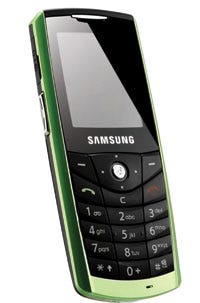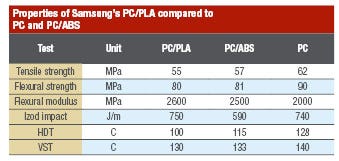Can alloys of polylactic acid (PLA) and traditional petrochemical plastics give designers a greener material that still satisfies product requirements?
July 16, 2009
Can alloys of polylactic acid (PLA) and traditional petrochemical plastics give designers a greener material that still satisfies product requirements?
In several instances, the answer appears to be yes. In June 2008, Korean conglomerate Samsung introduced its first mobile phone with bioplastic content-the W510-at the World IT Show in Seoul, and by the Summer Olympics in Beijing it had launched its third “eco-phone”, the E200 Eco. For that phone, Cheil Industries, a division of the Samsung Group, developed a PLA for the handset’s case that was 100% bioplastic, while others utilized a polycarbonate (PC)/PLA blend.
|
In a presentation at the Society of Plastics Engineers (SPE; Brookfield, CT) Global Plastics Environmental Conference (GPEC; Feb. 25-27; Orlando), Cheil’s Youngmi Chung laid out her company’s work towards “sustainable and durable” materials, with a focus on PC/PLA alloys.
Chung said Samsung wanted to improve PLA’s cycle time and flowability and weighed the use of a nucleating agent to promote crystal formation and greater heat stability, as well as a compatibilizer to boost impact strength. Cheil ultimately developed a PC/PLA blend called GL-1401, which it says had better fatigue resistance than PC/acrylonitrile butadiene styrene (ABS), a common mobile phone housing material, and with higher flow rates compared to PC and PC/ABS using a spiral flow test. In the test, PC/PLA flow registered 200 at 260°C, compared to 140 at 270°C for PC/ABS, and 120 for PC at 200°C.
Chung said Samsung has been able to boost PLA content from 30% to 50%, and to accommodate the temperature sensitivity of PLA, a lower-molecular-weight PC that processes at 240°C is used. In keeping with the housing’s green emphasis, a phosphorous-based non-halogen flame retardant is utilized and Samsung eliminated heavy metals like cadmium.
According to Chung, the company’s GL-1401 PC/PLA alloy registered a higher Izod impact strength than PC/ABS, at 750 J/m compared to 590 J/m (Joules/meter), with flexural modulus better as well at 2600 MPa vs. 2500 MPa (see table, next page).
Bayer MaterialScience (Leverkusen, Germany) has also been experimenting with PC/PLA blends creating Makroblend BC250 and BC400, with 25% and 40% PLA content respectively. Also at GPEC, Bayer’s James Chung said the result is a naturally white resin with “outstanding” impact strength and high flexural and tensile modulus. The heat-deflection temperature (HDT) at 264 psi for BC250 is 99°C and 59°C for BC40. At 66 psi, BC250’s HDT is 131°C, with BC400 registering 99°C. Chung says BC250 compares favorably to an impact-modified PC, with some properties actually higher for the PLA blend. Chung did have some caveats for the material, recommending opaque pigmentation, film inserts for high-humidity environs, and coatings for higher-heat situations.
Optimizing PLA
Corey Linden, with the research and commercialization firm Battelle, used GPEC to highlight a series of studies his company has done into PLA, including modifications to improve its processing and performance by looking at fillers, clarifiers, and post-processing annealing techniques like microwave energy and ultrasonics.
In terms of boosting crystallization, Battelle’s research found three methods worked well: introducing talc and EBS fillers at different loading percentages as a nucleating agent; injection into a heated mold; and post-mold annealing. The researchers also weighed the affect of clarifiers, filler size, and final crystalline content on the crystallization rate.
Linden and Battelle determined that filler size for the talc grades had little influence on how crystals are formed, and that in processed parts that can be annealed, clarifiers can increase part crystallinity and result in clear product. Battelle concluded that post-processing annealing of PLA moldings as a means to boost clarity was more desirable than extending the injection molding machine’s cycle time.
PLA in the frozen food aisle
PolyNew (Golden, CO), which was a runner up in GPEC’s Clean Technology business forum, shared its latest work to improve PLA, infusing the bioresin with what it calls cellulosic nanowhiskers to create sheet that’s suitable for thermoformed frozen food trays. Working in conjunction with Sealed Air, PolyNew is developing a package for Stouffer’s frozen food brand that could withstand hot fill, freezing, and microwaving. PolyNew’s John Dorgan, who also works as a professor at the Colorado School of Mines department of chemical and biochemical engineering, said the company is also researching coffee cup lids made from the biocomposite.
The company’s proprietary technology involves the surface functionalization of cellulose fibers creating hydrophobic cellulosic nanowhiskers. The fibers are culled from cotton linter using acid hydrolysis. At 10% loading, the nanowhiskers boosted the PLA’s heat-deflection temperature to 120°C, and as Dorgan pointed out, “you’d actually like to use more because [nanowhiskers] are cheaper than PLA.” The whiskers themselves measure 200 by 10 nanometers, and the cellulose they’re derived from boast a glass-transition temperature of 220°C and offer inherent barrier properties. Dorgan says even PLAs loaded with 10-12% by weight nanowhiskers offer good clarity. “A renewable-resource based family of PLA nanocomposites is emerging,” Dorgan said. “These ecobionanocomposites have improved HDTs while maintaining transparency and degradability.” —[email protected]
eweekly_Jan2_Leistritz |
About the Author(s)
You May Also Like






